Tourism and Hospitality Marketing Strategies for Baby Boomers - Report
VerifiedAdded on 2022/05/20
|29
|9481
|27
Report
AI Summary
This report delves into the tourism and hospitality marketing sector, focusing on the baby boomer generation and their impact on the industry. It begins with an introduction to baby boomers, their key features, and emerging trends, followed by an analysis of their consumer behavior and application of segmentation, targeting, and positioning (STP) strategies. The report examines the buyer decision process and includes a practical example of destination selection. It also presents a research study, defining the problem, objectives, and data collection methods, along with findings and recommendations. Furthermore, the report analyzes a self-owned organic restaurant, covering internal and external analysis using PESTEL and SWOT frameworks, segmentation, targeting, positioning, and marketing mix strategies (4Ps or 7Ps). The report concludes with recommendations for the restaurant and references relevant academic sources.
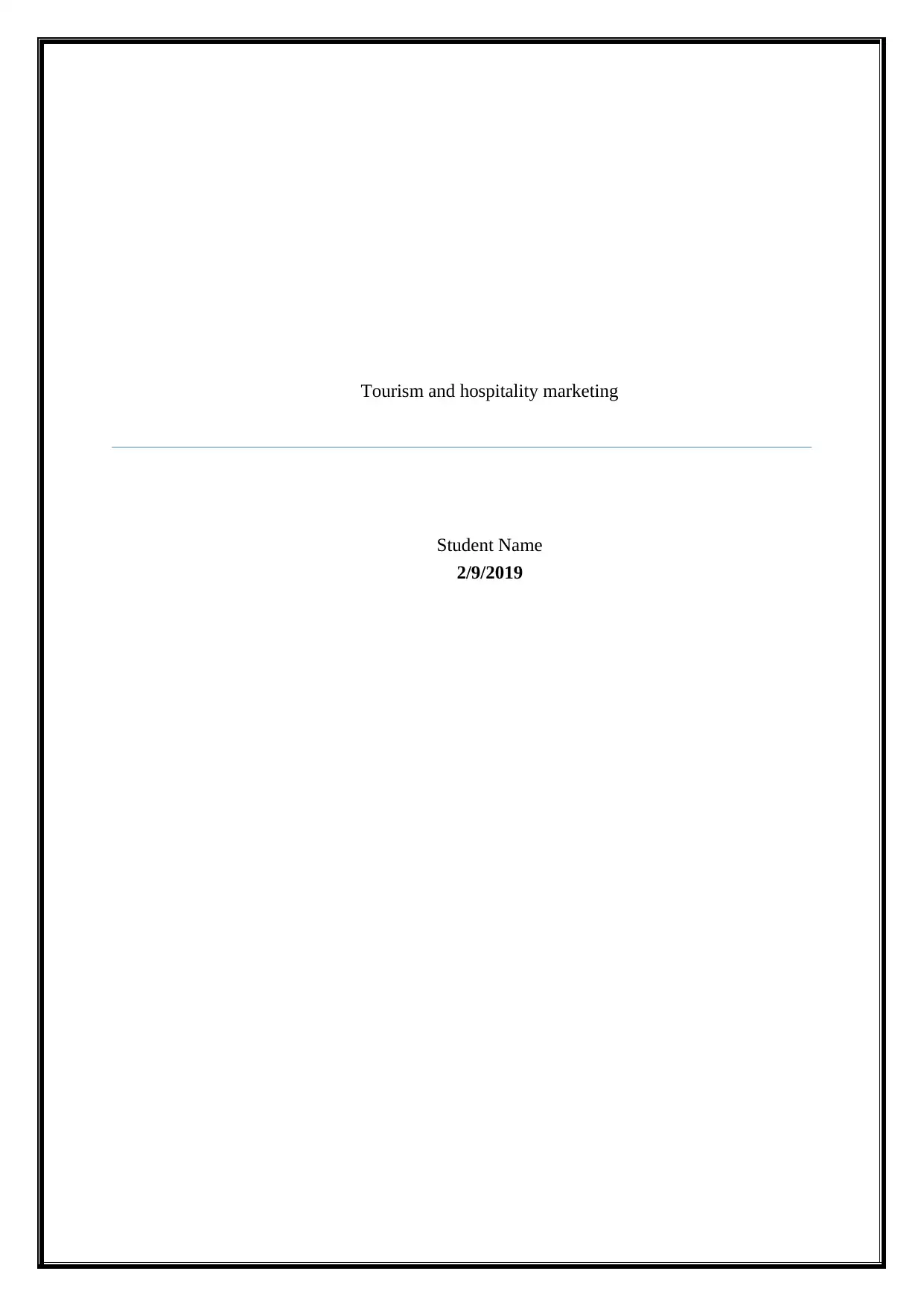
Tourism and hospitality marketing
Student Name
2/9/2019
Student Name
2/9/2019
Paraphrase This Document
Need a fresh take? Get an instant paraphrase of this document with our AI Paraphraser
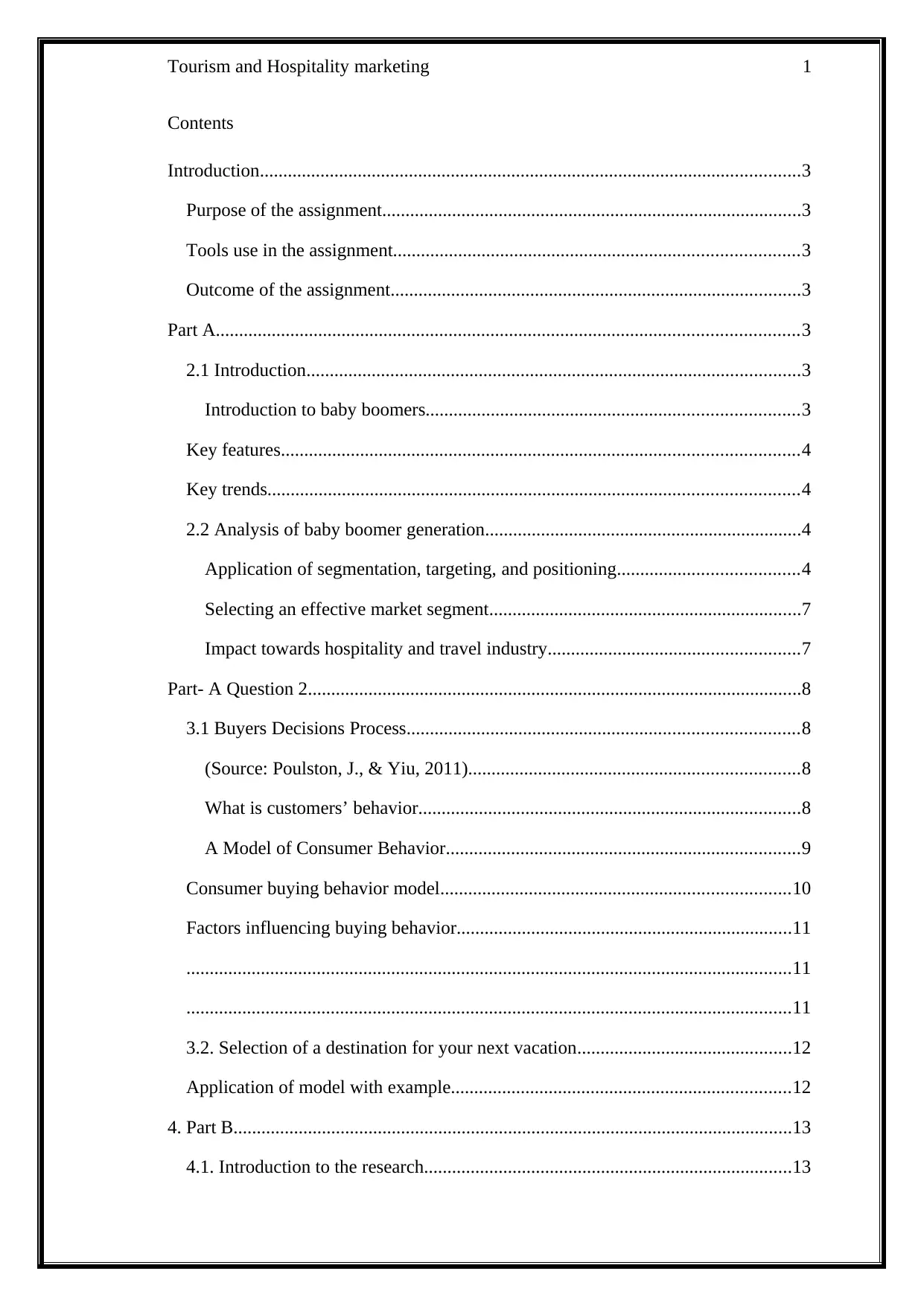
Tourism and Hospitality marketing 1
Contents
Introduction....................................................................................................................3
Purpose of the assignment..........................................................................................3
Tools use in the assignment.......................................................................................3
Outcome of the assignment........................................................................................3
Part A.............................................................................................................................3
2.1 Introduction..........................................................................................................3
Introduction to baby boomers................................................................................3
Key features...............................................................................................................4
Key trends..................................................................................................................4
2.2 Analysis of baby boomer generation....................................................................4
Application of segmentation, targeting, and positioning.......................................4
Selecting an effective market segment...................................................................7
Impact towards hospitality and travel industry......................................................7
Part- A Question 2..........................................................................................................8
3.1 Buyers Decisions Process....................................................................................8
(Source: Poulston, J., & Yiu, 2011).......................................................................8
What is customers’ behavior..................................................................................8
A Model of Consumer Behavior............................................................................9
Consumer buying behavior model...........................................................................10
Factors influencing buying behavior........................................................................11
..................................................................................................................................11
..................................................................................................................................11
3.2. Selection of a destination for your next vacation..............................................12
Application of model with example.........................................................................12
4. Part B........................................................................................................................13
4.1. Introduction to the research...............................................................................13
Contents
Introduction....................................................................................................................3
Purpose of the assignment..........................................................................................3
Tools use in the assignment.......................................................................................3
Outcome of the assignment........................................................................................3
Part A.............................................................................................................................3
2.1 Introduction..........................................................................................................3
Introduction to baby boomers................................................................................3
Key features...............................................................................................................4
Key trends..................................................................................................................4
2.2 Analysis of baby boomer generation....................................................................4
Application of segmentation, targeting, and positioning.......................................4
Selecting an effective market segment...................................................................7
Impact towards hospitality and travel industry......................................................7
Part- A Question 2..........................................................................................................8
3.1 Buyers Decisions Process....................................................................................8
(Source: Poulston, J., & Yiu, 2011).......................................................................8
What is customers’ behavior..................................................................................8
A Model of Consumer Behavior............................................................................9
Consumer buying behavior model...........................................................................10
Factors influencing buying behavior........................................................................11
..................................................................................................................................11
..................................................................................................................................11
3.2. Selection of a destination for your next vacation..............................................12
Application of model with example.........................................................................12
4. Part B........................................................................................................................13
4.1. Introduction to the research...............................................................................13
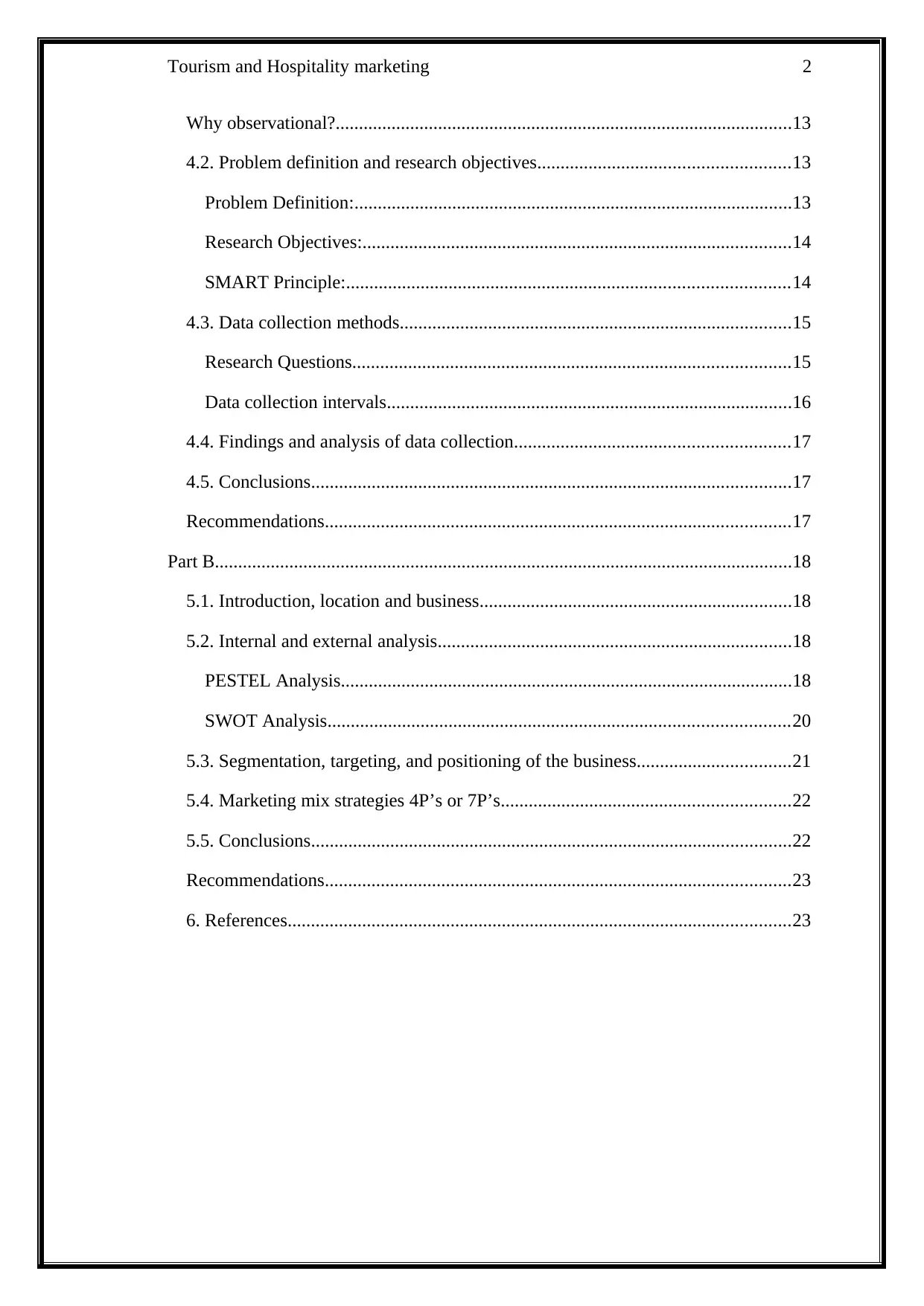
Tourism and Hospitality marketing 2
Why observational?..................................................................................................13
4.2. Problem definition and research objectives......................................................13
Problem Definition:..............................................................................................13
Research Objectives:............................................................................................14
SMART Principle:...............................................................................................14
4.3. Data collection methods....................................................................................15
Research Questions..............................................................................................15
Data collection intervals.......................................................................................16
4.4. Findings and analysis of data collection...........................................................17
4.5. Conclusions.......................................................................................................17
Recommendations....................................................................................................17
Part B............................................................................................................................18
5.1. Introduction, location and business...................................................................18
5.2. Internal and external analysis............................................................................18
PESTEL Analysis.................................................................................................18
SWOT Analysis...................................................................................................20
5.3. Segmentation, targeting, and positioning of the business.................................21
5.4. Marketing mix strategies 4P’s or 7P’s..............................................................22
5.5. Conclusions.......................................................................................................22
Recommendations....................................................................................................23
6. References............................................................................................................23
Why observational?..................................................................................................13
4.2. Problem definition and research objectives......................................................13
Problem Definition:..............................................................................................13
Research Objectives:............................................................................................14
SMART Principle:...............................................................................................14
4.3. Data collection methods....................................................................................15
Research Questions..............................................................................................15
Data collection intervals.......................................................................................16
4.4. Findings and analysis of data collection...........................................................17
4.5. Conclusions.......................................................................................................17
Recommendations....................................................................................................17
Part B............................................................................................................................18
5.1. Introduction, location and business...................................................................18
5.2. Internal and external analysis............................................................................18
PESTEL Analysis.................................................................................................18
SWOT Analysis...................................................................................................20
5.3. Segmentation, targeting, and positioning of the business.................................21
5.4. Marketing mix strategies 4P’s or 7P’s..............................................................22
5.5. Conclusions.......................................................................................................22
Recommendations....................................................................................................23
6. References............................................................................................................23
⊘ This is a preview!⊘
Do you want full access?
Subscribe today to unlock all pages.

Trusted by 1+ million students worldwide
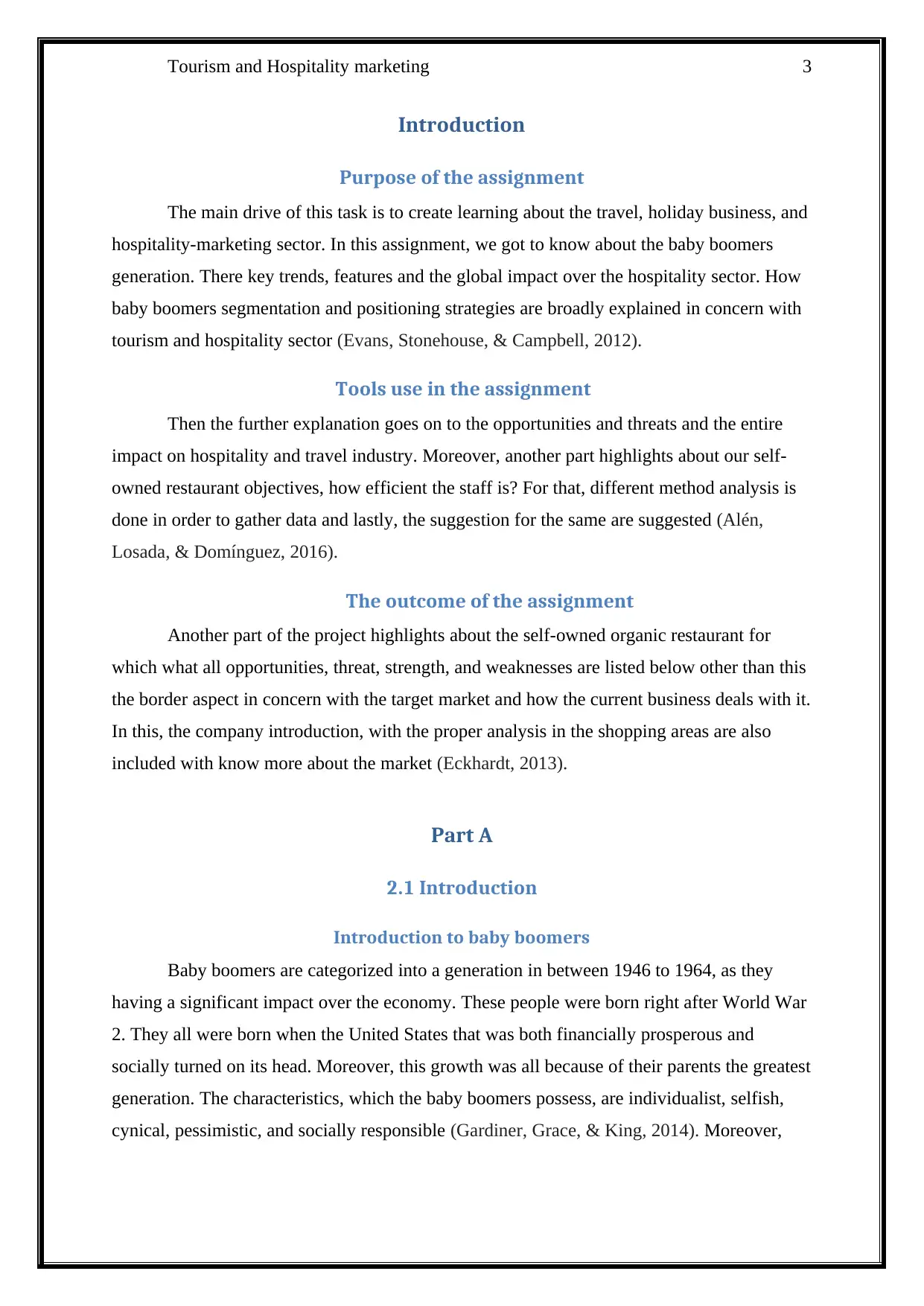
Tourism and Hospitality marketing 3
Introduction
Purpose of the assignment
The main drive of this task is to create learning about the travel, holiday business, and
hospitality-marketing sector. In this assignment, we got to know about the baby boomers
generation. There key trends, features and the global impact over the hospitality sector. How
baby boomers segmentation and positioning strategies are broadly explained in concern with
tourism and hospitality sector (Evans, Stonehouse, & Campbell, 2012).
Tools use in the assignment
Then the further explanation goes on to the opportunities and threats and the entire
impact on hospitality and travel industry. Moreover, another part highlights about our self-
owned restaurant objectives, how efficient the staff is? For that, different method analysis is
done in order to gather data and lastly, the suggestion for the same are suggested (Alén,
Losada, & Domínguez, 2016).
The outcome of the assignment
Another part of the project highlights about the self-owned organic restaurant for
which what all opportunities, threat, strength, and weaknesses are listed below other than this
the border aspect in concern with the target market and how the current business deals with it.
In this, the company introduction, with the proper analysis in the shopping areas are also
included with know more about the market (Eckhardt, 2013).
Part A
2.1 Introduction
Introduction to baby boomers
Baby boomers are categorized into a generation in between 1946 to 1964, as they
having a significant impact over the economy. These people were born right after World War
2. They all were born when the United States that was both financially prosperous and
socially turned on its head. Moreover, this growth was all because of their parents the greatest
generation. The characteristics, which the baby boomers possess, are individualist, selfish,
cynical, pessimistic, and socially responsible (Gardiner, Grace, & King, 2014). Moreover,
Introduction
Purpose of the assignment
The main drive of this task is to create learning about the travel, holiday business, and
hospitality-marketing sector. In this assignment, we got to know about the baby boomers
generation. There key trends, features and the global impact over the hospitality sector. How
baby boomers segmentation and positioning strategies are broadly explained in concern with
tourism and hospitality sector (Evans, Stonehouse, & Campbell, 2012).
Tools use in the assignment
Then the further explanation goes on to the opportunities and threats and the entire
impact on hospitality and travel industry. Moreover, another part highlights about our self-
owned restaurant objectives, how efficient the staff is? For that, different method analysis is
done in order to gather data and lastly, the suggestion for the same are suggested (Alén,
Losada, & Domínguez, 2016).
The outcome of the assignment
Another part of the project highlights about the self-owned organic restaurant for
which what all opportunities, threat, strength, and weaknesses are listed below other than this
the border aspect in concern with the target market and how the current business deals with it.
In this, the company introduction, with the proper analysis in the shopping areas are also
included with know more about the market (Eckhardt, 2013).
Part A
2.1 Introduction
Introduction to baby boomers
Baby boomers are categorized into a generation in between 1946 to 1964, as they
having a significant impact over the economy. These people were born right after World War
2. They all were born when the United States that was both financially prosperous and
socially turned on its head. Moreover, this growth was all because of their parents the greatest
generation. The characteristics, which the baby boomers possess, are individualist, selfish,
cynical, pessimistic, and socially responsible (Gardiner, Grace, & King, 2014). Moreover,
Paraphrase This Document
Need a fresh take? Get an instant paraphrase of this document with our AI Paraphraser
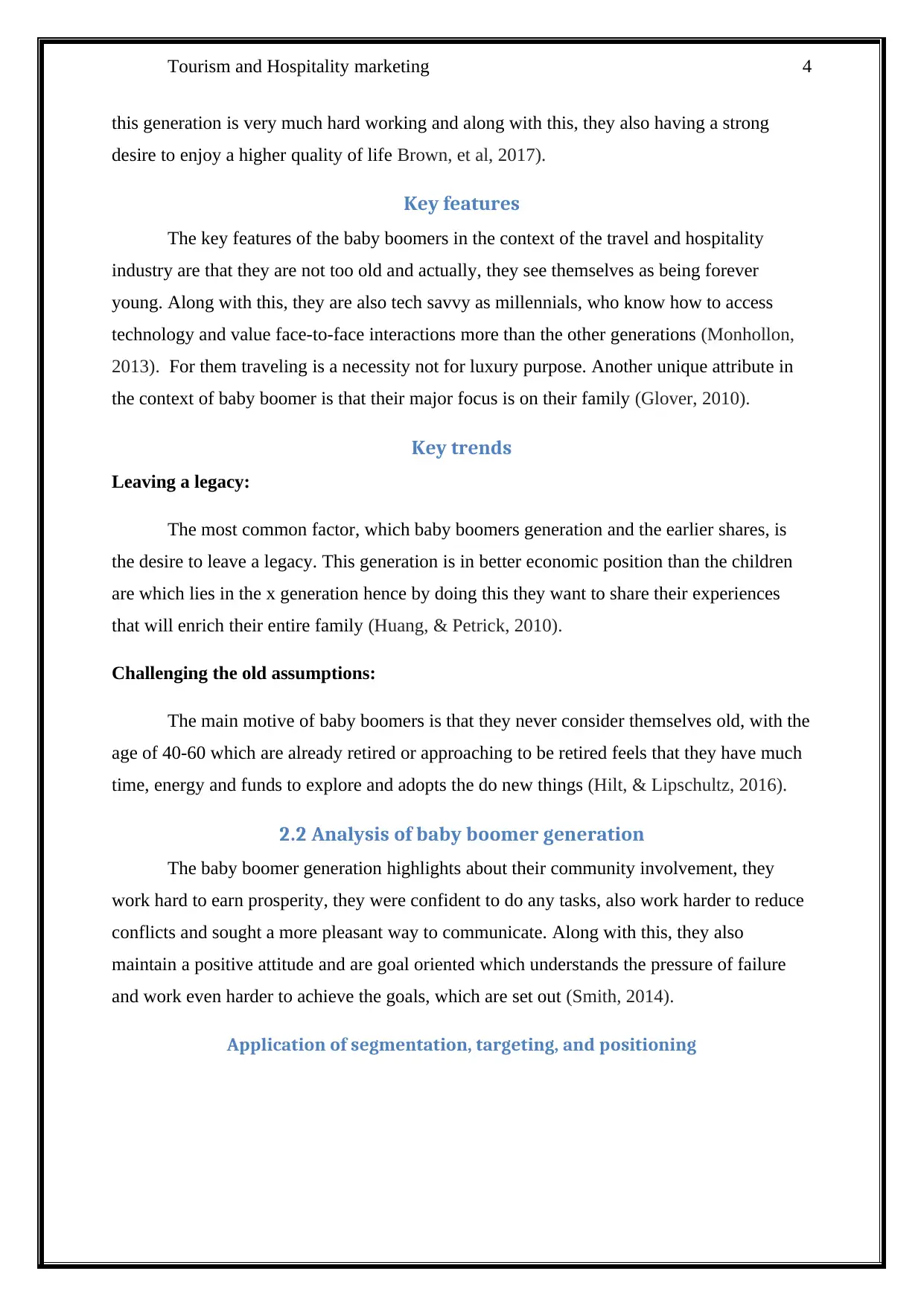
Tourism and Hospitality marketing 4
this generation is very much hard working and along with this, they also having a strong
desire to enjoy a higher quality of life Brown, et al, 2017).
Key features
The key features of the baby boomers in the context of the travel and hospitality
industry are that they are not too old and actually, they see themselves as being forever
young. Along with this, they are also tech savvy as millennials, who know how to access
technology and value face-to-face interactions more than the other generations (Monhollon,
2013). For them traveling is a necessity not for luxury purpose. Another unique attribute in
the context of baby boomer is that their major focus is on their family (Glover, 2010).
Key trends
Leaving a legacy:
The most common factor, which baby boomers generation and the earlier shares, is
the desire to leave a legacy. This generation is in better economic position than the children
are which lies in the x generation hence by doing this they want to share their experiences
that will enrich their entire family (Huang, & Petrick, 2010).
Challenging the old assumptions:
The main motive of baby boomers is that they never consider themselves old, with the
age of 40-60 which are already retired or approaching to be retired feels that they have much
time, energy and funds to explore and adopts the do new things (Hilt, & Lipschultz, 2016).
2.2 Analysis of baby boomer generation
The baby boomer generation highlights about their community involvement, they
work hard to earn prosperity, they were confident to do any tasks, also work harder to reduce
conflicts and sought a more pleasant way to communicate. Along with this, they also
maintain a positive attitude and are goal oriented which understands the pressure of failure
and work even harder to achieve the goals, which are set out (Smith, 2014).
Application of segmentation, targeting, and positioning
this generation is very much hard working and along with this, they also having a strong
desire to enjoy a higher quality of life Brown, et al, 2017).
Key features
The key features of the baby boomers in the context of the travel and hospitality
industry are that they are not too old and actually, they see themselves as being forever
young. Along with this, they are also tech savvy as millennials, who know how to access
technology and value face-to-face interactions more than the other generations (Monhollon,
2013). For them traveling is a necessity not for luxury purpose. Another unique attribute in
the context of baby boomer is that their major focus is on their family (Glover, 2010).
Key trends
Leaving a legacy:
The most common factor, which baby boomers generation and the earlier shares, is
the desire to leave a legacy. This generation is in better economic position than the children
are which lies in the x generation hence by doing this they want to share their experiences
that will enrich their entire family (Huang, & Petrick, 2010).
Challenging the old assumptions:
The main motive of baby boomers is that they never consider themselves old, with the
age of 40-60 which are already retired or approaching to be retired feels that they have much
time, energy and funds to explore and adopts the do new things (Hilt, & Lipschultz, 2016).
2.2 Analysis of baby boomer generation
The baby boomer generation highlights about their community involvement, they
work hard to earn prosperity, they were confident to do any tasks, also work harder to reduce
conflicts and sought a more pleasant way to communicate. Along with this, they also
maintain a positive attitude and are goal oriented which understands the pressure of failure
and work even harder to achieve the goals, which are set out (Smith, 2014).
Application of segmentation, targeting, and positioning
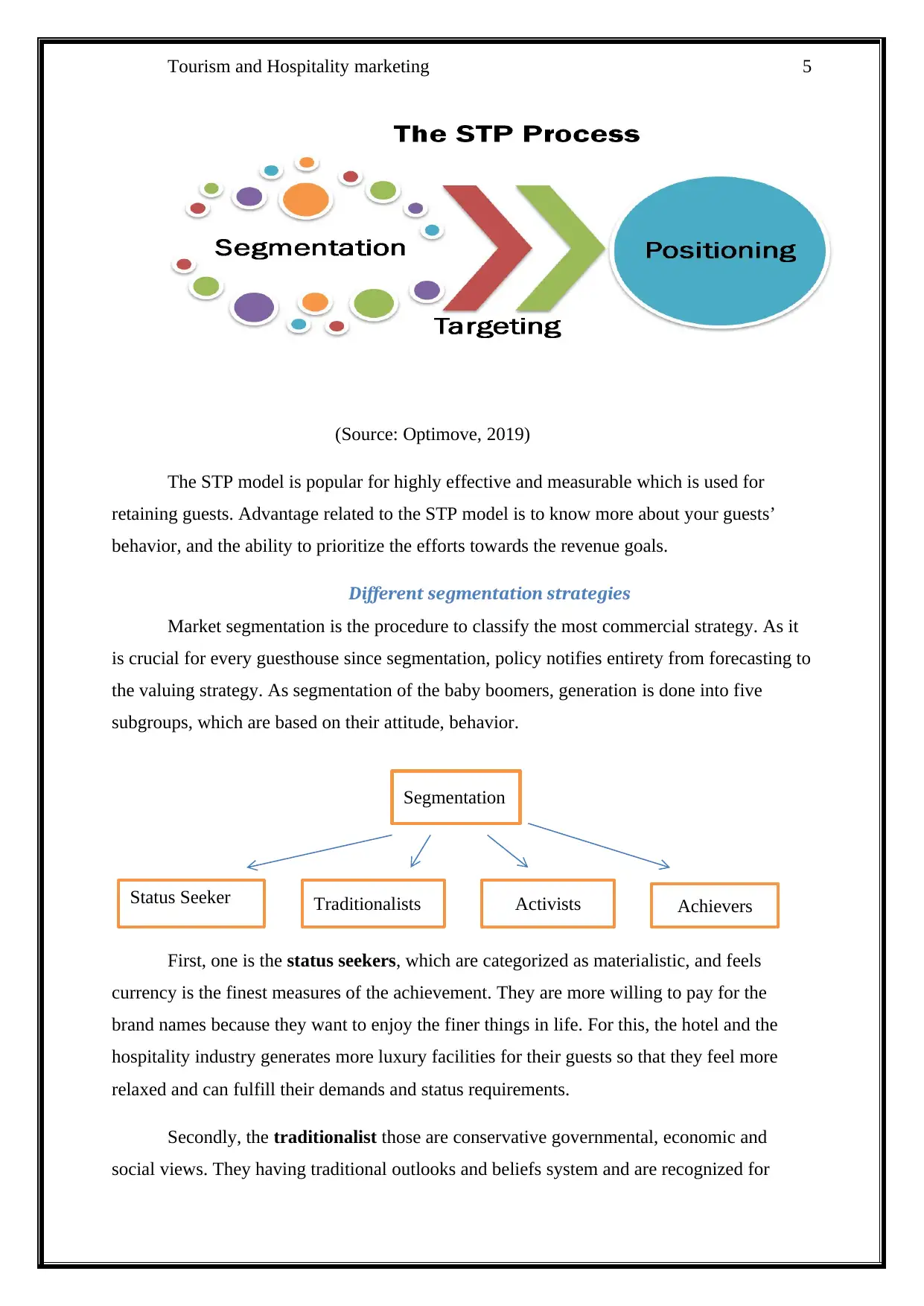
Tourism and Hospitality marketing 5
(Source: Optimove, 2019)
The STP model is popular for highly effective and measurable which is used for
retaining guests. Advantage related to the STP model is to know more about your guests’
behavior, and the ability to prioritize the efforts towards the revenue goals.
Different segmentation strategies
Market segmentation is the procedure to classify the most commercial strategy. As it
is crucial for every guesthouse since segmentation, policy notifies entirety from forecasting to
the valuing strategy. As segmentation of the baby boomers, generation is done into five
subgroups, which are based on their attitude, behavior.
First, one is the status seekers, which are categorized as materialistic, and feels
currency is the finest measures of the achievement. They are more willing to pay for the
brand names because they want to enjoy the finer things in life. For this, the hotel and the
hospitality industry generates more luxury facilities for their guests so that they feel more
relaxed and can fulfill their demands and status requirements.
Secondly, the traditionalist those are conservative governmental, economic and
social views. They having traditional outlooks and beliefs system and are recognized for
Segmentation
Status Seeker Traditionalists Activists Achievers
(Source: Optimove, 2019)
The STP model is popular for highly effective and measurable which is used for
retaining guests. Advantage related to the STP model is to know more about your guests’
behavior, and the ability to prioritize the efforts towards the revenue goals.
Different segmentation strategies
Market segmentation is the procedure to classify the most commercial strategy. As it
is crucial for every guesthouse since segmentation, policy notifies entirety from forecasting to
the valuing strategy. As segmentation of the baby boomers, generation is done into five
subgroups, which are based on their attitude, behavior.
First, one is the status seekers, which are categorized as materialistic, and feels
currency is the finest measures of the achievement. They are more willing to pay for the
brand names because they want to enjoy the finer things in life. For this, the hotel and the
hospitality industry generates more luxury facilities for their guests so that they feel more
relaxed and can fulfill their demands and status requirements.
Secondly, the traditionalist those are conservative governmental, economic and
social views. They having traditional outlooks and beliefs system and are recognized for
Segmentation
Status Seeker Traditionalists Activists Achievers
⊘ This is a preview!⊘
Do you want full access?
Subscribe today to unlock all pages.

Trusted by 1+ million students worldwide
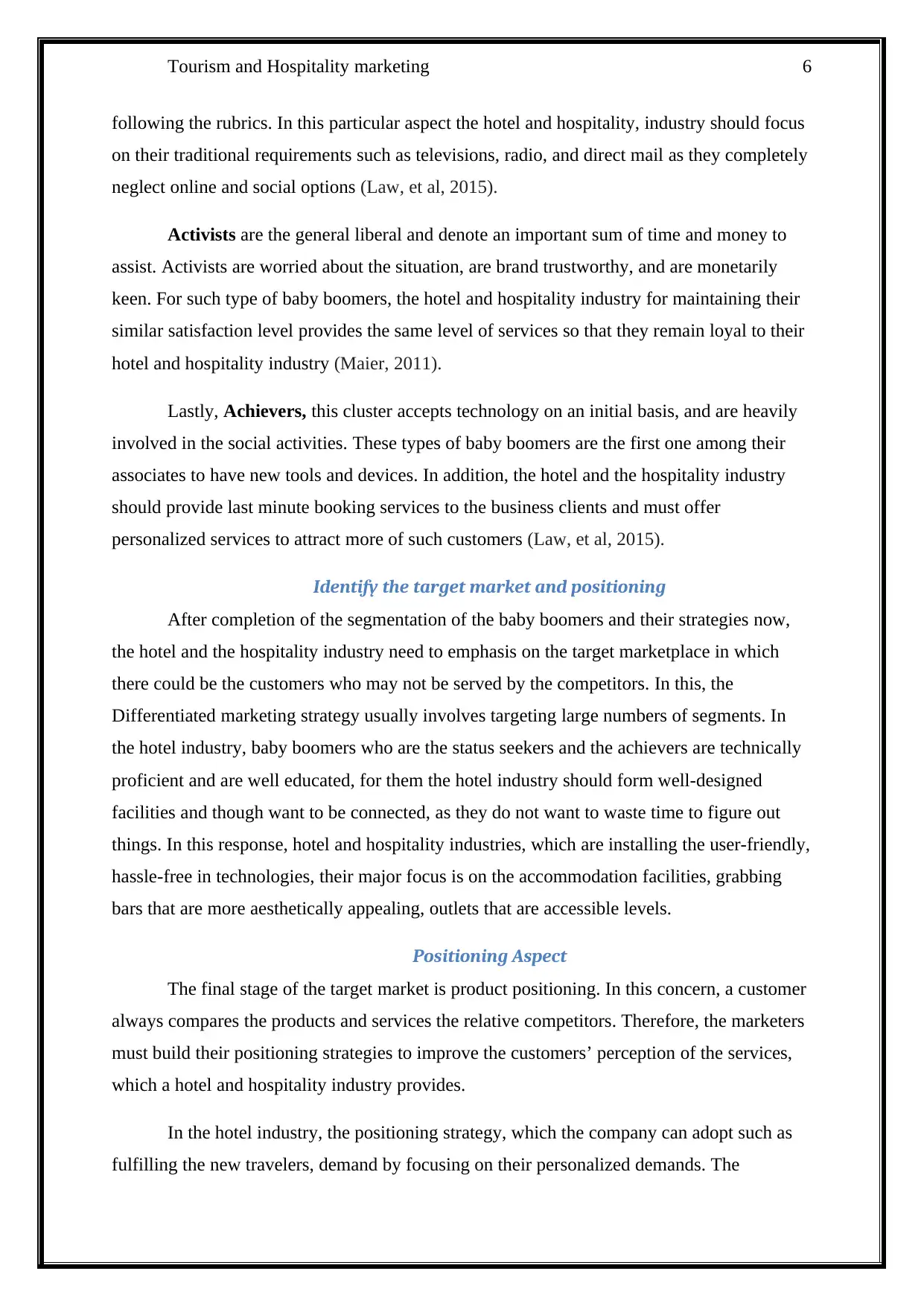
Tourism and Hospitality marketing 6
following the rubrics. In this particular aspect the hotel and hospitality, industry should focus
on their traditional requirements such as televisions, radio, and direct mail as they completely
neglect online and social options (Law, et al, 2015).
Activists are the general liberal and denote an important sum of time and money to
assist. Activists are worried about the situation, are brand trustworthy, and are monetarily
keen. For such type of baby boomers, the hotel and hospitality industry for maintaining their
similar satisfaction level provides the same level of services so that they remain loyal to their
hotel and hospitality industry (Maier, 2011).
Lastly, Achievers, this cluster accepts technology on an initial basis, and are heavily
involved in the social activities. These types of baby boomers are the first one among their
associates to have new tools and devices. In addition, the hotel and the hospitality industry
should provide last minute booking services to the business clients and must offer
personalized services to attract more of such customers (Law, et al, 2015).
Identify the target market and positioning
After completion of the segmentation of the baby boomers and their strategies now,
the hotel and the hospitality industry need to emphasis on the target marketplace in which
there could be the customers who may not be served by the competitors. In this, the
Differentiated marketing strategy usually involves targeting large numbers of segments. In
the hotel industry, baby boomers who are the status seekers and the achievers are technically
proficient and are well educated, for them the hotel industry should form well-designed
facilities and though want to be connected, as they do not want to waste time to figure out
things. In this response, hotel and hospitality industries, which are installing the user-friendly,
hassle-free in technologies, their major focus is on the accommodation facilities, grabbing
bars that are more aesthetically appealing, outlets that are accessible levels.
Positioning Aspect
The final stage of the target market is product positioning. In this concern, a customer
always compares the products and services the relative competitors. Therefore, the marketers
must build their positioning strategies to improve the customers’ perception of the services,
which a hotel and hospitality industry provides.
In the hotel industry, the positioning strategy, which the company can adopt such as
fulfilling the new travelers, demand by focusing on their personalized demands. The
following the rubrics. In this particular aspect the hotel and hospitality, industry should focus
on their traditional requirements such as televisions, radio, and direct mail as they completely
neglect online and social options (Law, et al, 2015).
Activists are the general liberal and denote an important sum of time and money to
assist. Activists are worried about the situation, are brand trustworthy, and are monetarily
keen. For such type of baby boomers, the hotel and hospitality industry for maintaining their
similar satisfaction level provides the same level of services so that they remain loyal to their
hotel and hospitality industry (Maier, 2011).
Lastly, Achievers, this cluster accepts technology on an initial basis, and are heavily
involved in the social activities. These types of baby boomers are the first one among their
associates to have new tools and devices. In addition, the hotel and the hospitality industry
should provide last minute booking services to the business clients and must offer
personalized services to attract more of such customers (Law, et al, 2015).
Identify the target market and positioning
After completion of the segmentation of the baby boomers and their strategies now,
the hotel and the hospitality industry need to emphasis on the target marketplace in which
there could be the customers who may not be served by the competitors. In this, the
Differentiated marketing strategy usually involves targeting large numbers of segments. In
the hotel industry, baby boomers who are the status seekers and the achievers are technically
proficient and are well educated, for them the hotel industry should form well-designed
facilities and though want to be connected, as they do not want to waste time to figure out
things. In this response, hotel and hospitality industries, which are installing the user-friendly,
hassle-free in technologies, their major focus is on the accommodation facilities, grabbing
bars that are more aesthetically appealing, outlets that are accessible levels.
Positioning Aspect
The final stage of the target market is product positioning. In this concern, a customer
always compares the products and services the relative competitors. Therefore, the marketers
must build their positioning strategies to improve the customers’ perception of the services,
which a hotel and hospitality industry provides.
In the hotel industry, the positioning strategy, which the company can adopt such as
fulfilling the new travelers, demand by focusing on their personalized demands. The
Paraphrase This Document
Need a fresh take? Get an instant paraphrase of this document with our AI Paraphraser
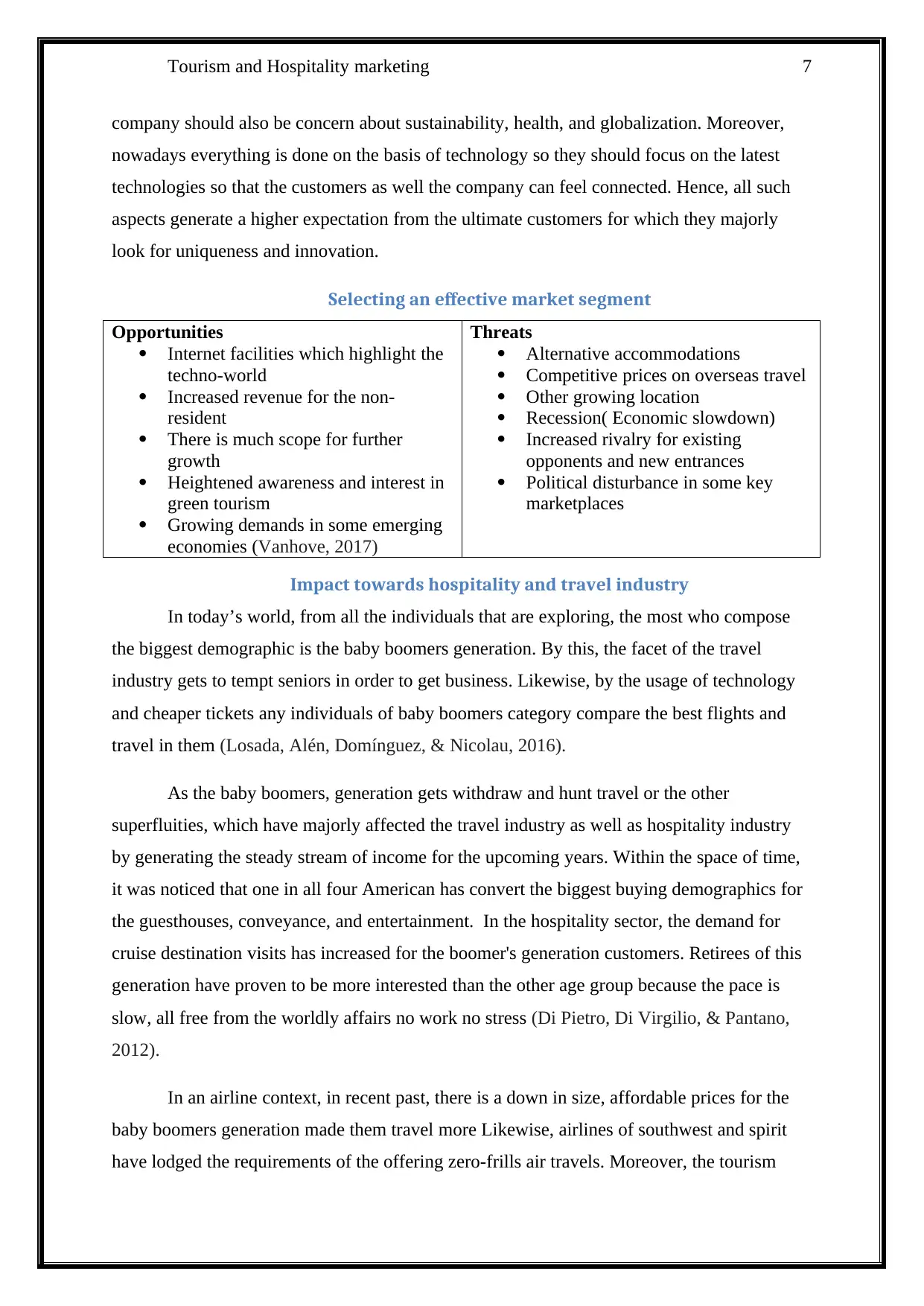
Tourism and Hospitality marketing 7
company should also be concern about sustainability, health, and globalization. Moreover,
nowadays everything is done on the basis of technology so they should focus on the latest
technologies so that the customers as well the company can feel connected. Hence, all such
aspects generate a higher expectation from the ultimate customers for which they majorly
look for uniqueness and innovation.
Selecting an effective market segment
Opportunities
Internet facilities which highlight the
techno-world
Increased revenue for the non-
resident
There is much scope for further
growth
Heightened awareness and interest in
green tourism
Growing demands in some emerging
economies (Vanhove, 2017)
Threats
Alternative accommodations
Competitive prices on overseas travel
Other growing location
Recession( Economic slowdown)
Increased rivalry for existing
opponents and new entrances
Political disturbance in some key
marketplaces
Impact towards hospitality and travel industry
In today’s world, from all the individuals that are exploring, the most who compose
the biggest demographic is the baby boomers generation. By this, the facet of the travel
industry gets to tempt seniors in order to get business. Likewise, by the usage of technology
and cheaper tickets any individuals of baby boomers category compare the best flights and
travel in them (Losada, Alén, Domínguez, & Nicolau, 2016).
As the baby boomers, generation gets withdraw and hunt travel or the other
superfluities, which have majorly affected the travel industry as well as hospitality industry
by generating the steady stream of income for the upcoming years. Within the space of time,
it was noticed that one in all four American has convert the biggest buying demographics for
the guesthouses, conveyance, and entertainment. In the hospitality sector, the demand for
cruise destination visits has increased for the boomer's generation customers. Retirees of this
generation have proven to be more interested than the other age group because the pace is
slow, all free from the worldly affairs no work no stress (Di Pietro, Di Virgilio, & Pantano,
2012).
In an airline context, in recent past, there is a down in size, affordable prices for the
baby boomers generation made them travel more Likewise, airlines of southwest and spirit
have lodged the requirements of the offering zero-frills air travels. Moreover, the tourism
company should also be concern about sustainability, health, and globalization. Moreover,
nowadays everything is done on the basis of technology so they should focus on the latest
technologies so that the customers as well the company can feel connected. Hence, all such
aspects generate a higher expectation from the ultimate customers for which they majorly
look for uniqueness and innovation.
Selecting an effective market segment
Opportunities
Internet facilities which highlight the
techno-world
Increased revenue for the non-
resident
There is much scope for further
growth
Heightened awareness and interest in
green tourism
Growing demands in some emerging
economies (Vanhove, 2017)
Threats
Alternative accommodations
Competitive prices on overseas travel
Other growing location
Recession( Economic slowdown)
Increased rivalry for existing
opponents and new entrances
Political disturbance in some key
marketplaces
Impact towards hospitality and travel industry
In today’s world, from all the individuals that are exploring, the most who compose
the biggest demographic is the baby boomers generation. By this, the facet of the travel
industry gets to tempt seniors in order to get business. Likewise, by the usage of technology
and cheaper tickets any individuals of baby boomers category compare the best flights and
travel in them (Losada, Alén, Domínguez, & Nicolau, 2016).
As the baby boomers, generation gets withdraw and hunt travel or the other
superfluities, which have majorly affected the travel industry as well as hospitality industry
by generating the steady stream of income for the upcoming years. Within the space of time,
it was noticed that one in all four American has convert the biggest buying demographics for
the guesthouses, conveyance, and entertainment. In the hospitality sector, the demand for
cruise destination visits has increased for the boomer's generation customers. Retirees of this
generation have proven to be more interested than the other age group because the pace is
slow, all free from the worldly affairs no work no stress (Di Pietro, Di Virgilio, & Pantano,
2012).
In an airline context, in recent past, there is a down in size, affordable prices for the
baby boomers generation made them travel more Likewise, airlines of southwest and spirit
have lodged the requirements of the offering zero-frills air travels. Moreover, the tourism
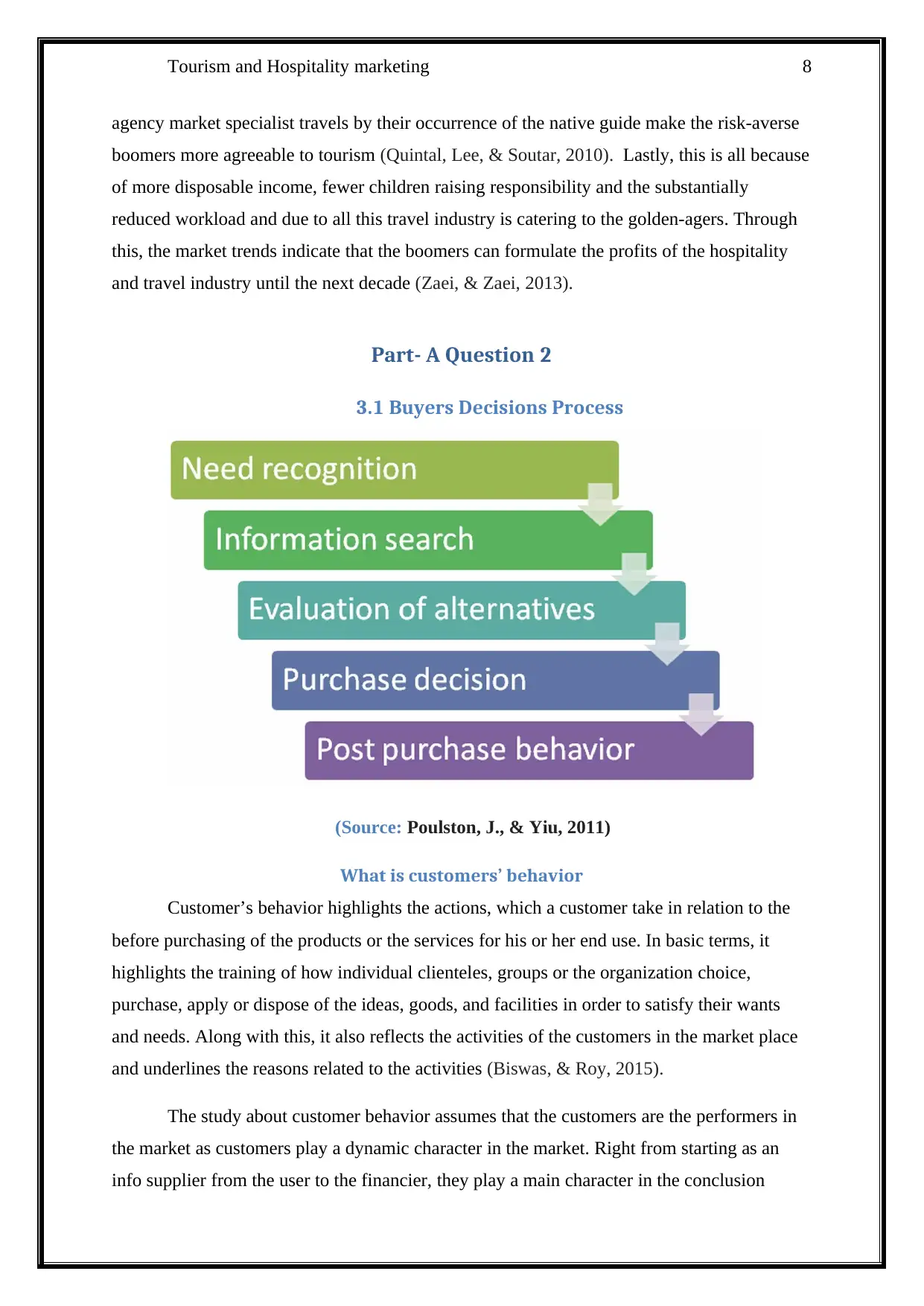
Tourism and Hospitality marketing 8
agency market specialist travels by their occurrence of the native guide make the risk-averse
boomers more agreeable to tourism (Quintal, Lee, & Soutar, 2010). Lastly, this is all because
of more disposable income, fewer children raising responsibility and the substantially
reduced workload and due to all this travel industry is catering to the golden-agers. Through
this, the market trends indicate that the boomers can formulate the profits of the hospitality
and travel industry until the next decade (Zaei, & Zaei, 2013).
Part- A Question 2
3.1 Buyers Decisions Process
(Source: Poulston, J., & Yiu, 2011)
What is customers’ behavior
Customer’s behavior highlights the actions, which a customer take in relation to the
before purchasing of the products or the services for his or her end use. In basic terms, it
highlights the training of how individual clienteles, groups or the organization choice,
purchase, apply or dispose of the ideas, goods, and facilities in order to satisfy their wants
and needs. Along with this, it also reflects the activities of the customers in the market place
and underlines the reasons related to the activities (Biswas, & Roy, 2015).
The study about customer behavior assumes that the customers are the performers in
the market as customers play a dynamic character in the market. Right from starting as an
info supplier from the user to the financier, they play a main character in the conclusion
agency market specialist travels by their occurrence of the native guide make the risk-averse
boomers more agreeable to tourism (Quintal, Lee, & Soutar, 2010). Lastly, this is all because
of more disposable income, fewer children raising responsibility and the substantially
reduced workload and due to all this travel industry is catering to the golden-agers. Through
this, the market trends indicate that the boomers can formulate the profits of the hospitality
and travel industry until the next decade (Zaei, & Zaei, 2013).
Part- A Question 2
3.1 Buyers Decisions Process
(Source: Poulston, J., & Yiu, 2011)
What is customers’ behavior
Customer’s behavior highlights the actions, which a customer take in relation to the
before purchasing of the products or the services for his or her end use. In basic terms, it
highlights the training of how individual clienteles, groups or the organization choice,
purchase, apply or dispose of the ideas, goods, and facilities in order to satisfy their wants
and needs. Along with this, it also reflects the activities of the customers in the market place
and underlines the reasons related to the activities (Biswas, & Roy, 2015).
The study about customer behavior assumes that the customers are the performers in
the market as customers play a dynamic character in the market. Right from starting as an
info supplier from the user to the financier, they play a main character in the conclusion
⊘ This is a preview!⊘
Do you want full access?
Subscribe today to unlock all pages.

Trusted by 1+ million students worldwide
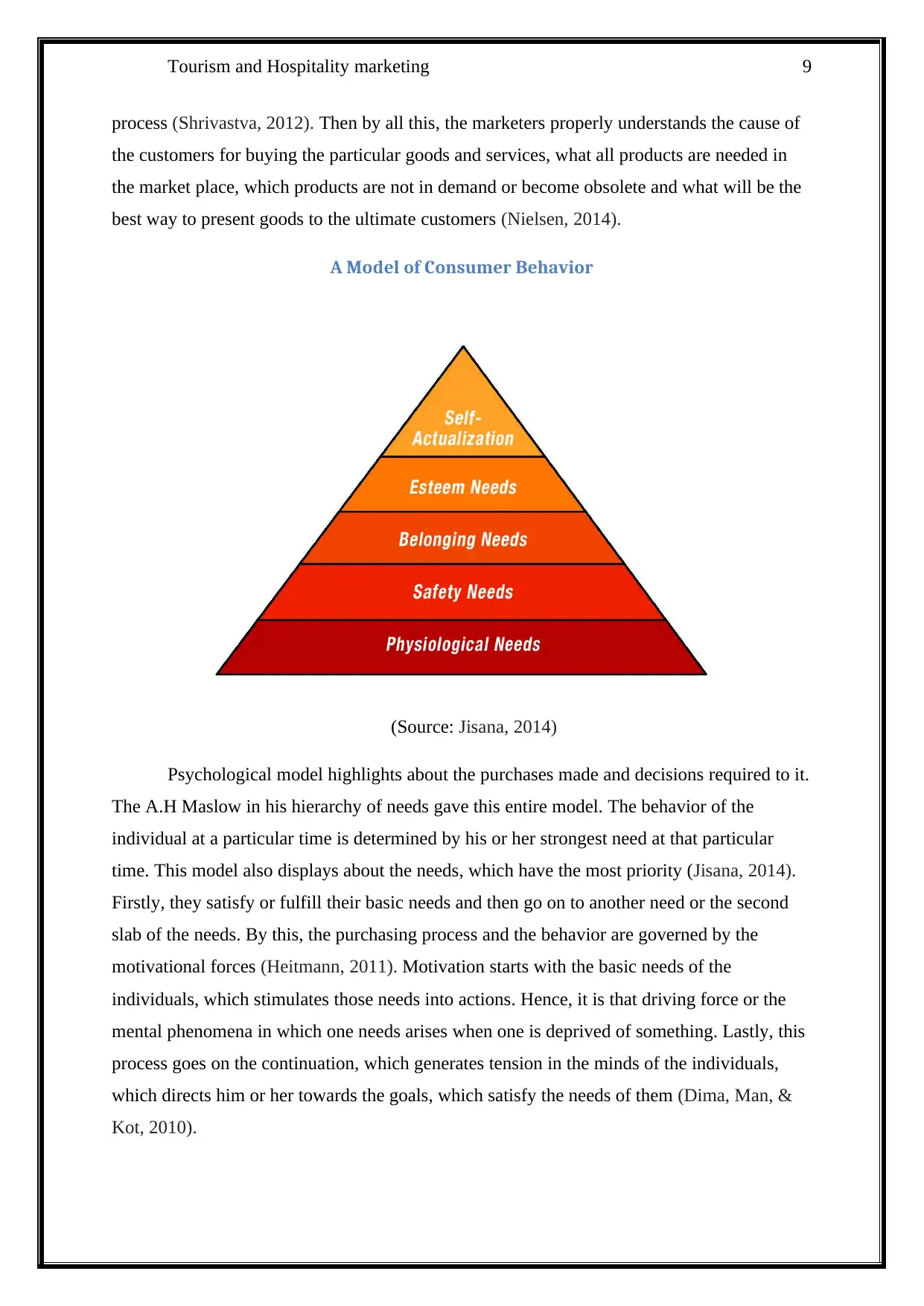
Tourism and Hospitality marketing 9
process (Shrivastva, 2012). Then by all this, the marketers properly understands the cause of
the customers for buying the particular goods and services, what all products are needed in
the market place, which products are not in demand or become obsolete and what will be the
best way to present goods to the ultimate customers (Nielsen, 2014).
A Model of Consumer Behavior
(Source: Jisana, 2014)
Psychological model highlights about the purchases made and decisions required to it.
The A.H Maslow in his hierarchy of needs gave this entire model. The behavior of the
individual at a particular time is determined by his or her strongest need at that particular
time. This model also displays about the needs, which have the most priority (Jisana, 2014).
Firstly, they satisfy or fulfill their basic needs and then go on to another need or the second
slab of the needs. By this, the purchasing process and the behavior are governed by the
motivational forces (Heitmann, 2011). Motivation starts with the basic needs of the
individuals, which stimulates those needs into actions. Hence, it is that driving force or the
mental phenomena in which one needs arises when one is deprived of something. Lastly, this
process goes on the continuation, which generates tension in the minds of the individuals,
which directs him or her towards the goals, which satisfy the needs of them (Dima, Man, &
Kot, 2010).
process (Shrivastva, 2012). Then by all this, the marketers properly understands the cause of
the customers for buying the particular goods and services, what all products are needed in
the market place, which products are not in demand or become obsolete and what will be the
best way to present goods to the ultimate customers (Nielsen, 2014).
A Model of Consumer Behavior
(Source: Jisana, 2014)
Psychological model highlights about the purchases made and decisions required to it.
The A.H Maslow in his hierarchy of needs gave this entire model. The behavior of the
individual at a particular time is determined by his or her strongest need at that particular
time. This model also displays about the needs, which have the most priority (Jisana, 2014).
Firstly, they satisfy or fulfill their basic needs and then go on to another need or the second
slab of the needs. By this, the purchasing process and the behavior are governed by the
motivational forces (Heitmann, 2011). Motivation starts with the basic needs of the
individuals, which stimulates those needs into actions. Hence, it is that driving force or the
mental phenomena in which one needs arises when one is deprived of something. Lastly, this
process goes on the continuation, which generates tension in the minds of the individuals,
which directs him or her towards the goals, which satisfy the needs of them (Dima, Man, &
Kot, 2010).
Paraphrase This Document
Need a fresh take? Get an instant paraphrase of this document with our AI Paraphraser
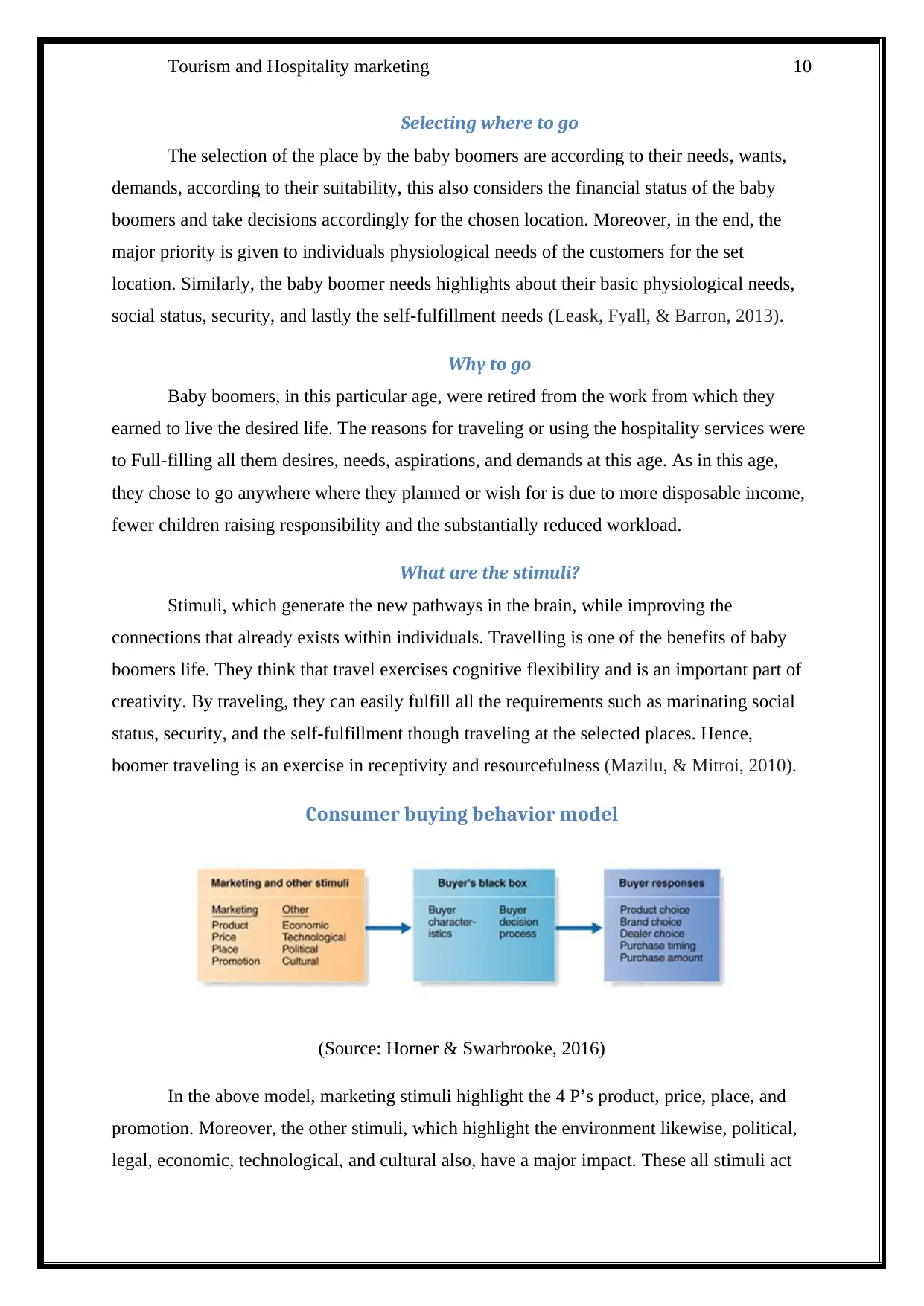
Tourism and Hospitality marketing 10
Selecting where to go
The selection of the place by the baby boomers are according to their needs, wants,
demands, according to their suitability, this also considers the financial status of the baby
boomers and take decisions accordingly for the chosen location. Moreover, in the end, the
major priority is given to individuals physiological needs of the customers for the set
location. Similarly, the baby boomer needs highlights about their basic physiological needs,
social status, security, and lastly the self-fulfillment needs (Leask, Fyall, & Barron, 2013).
Why to go
Baby boomers, in this particular age, were retired from the work from which they
earned to live the desired life. The reasons for traveling or using the hospitality services were
to Full-filling all them desires, needs, aspirations, and demands at this age. As in this age,
they chose to go anywhere where they planned or wish for is due to more disposable income,
fewer children raising responsibility and the substantially reduced workload.
What are the stimuli?
Stimuli, which generate the new pathways in the brain, while improving the
connections that already exists within individuals. Travelling is one of the benefits of baby
boomers life. They think that travel exercises cognitive flexibility and is an important part of
creativity. By traveling, they can easily fulfill all the requirements such as marinating social
status, security, and the self-fulfillment though traveling at the selected places. Hence,
boomer traveling is an exercise in receptivity and resourcefulness (Mazilu, & Mitroi, 2010).
Consumer buying behavior model
(Source: Horner & Swarbrooke, 2016)
In the above model, marketing stimuli highlight the 4 P’s product, price, place, and
promotion. Moreover, the other stimuli, which highlight the environment likewise, political,
legal, economic, technological, and cultural also, have a major impact. These all stimuli act
Selecting where to go
The selection of the place by the baby boomers are according to their needs, wants,
demands, according to their suitability, this also considers the financial status of the baby
boomers and take decisions accordingly for the chosen location. Moreover, in the end, the
major priority is given to individuals physiological needs of the customers for the set
location. Similarly, the baby boomer needs highlights about their basic physiological needs,
social status, security, and lastly the self-fulfillment needs (Leask, Fyall, & Barron, 2013).
Why to go
Baby boomers, in this particular age, were retired from the work from which they
earned to live the desired life. The reasons for traveling or using the hospitality services were
to Full-filling all them desires, needs, aspirations, and demands at this age. As in this age,
they chose to go anywhere where they planned or wish for is due to more disposable income,
fewer children raising responsibility and the substantially reduced workload.
What are the stimuli?
Stimuli, which generate the new pathways in the brain, while improving the
connections that already exists within individuals. Travelling is one of the benefits of baby
boomers life. They think that travel exercises cognitive flexibility and is an important part of
creativity. By traveling, they can easily fulfill all the requirements such as marinating social
status, security, and the self-fulfillment though traveling at the selected places. Hence,
boomer traveling is an exercise in receptivity and resourcefulness (Mazilu, & Mitroi, 2010).
Consumer buying behavior model
(Source: Horner & Swarbrooke, 2016)
In the above model, marketing stimuli highlight the 4 P’s product, price, place, and
promotion. Moreover, the other stimuli, which highlight the environment likewise, political,
legal, economic, technological, and cultural also, have a major impact. These all stimuli act
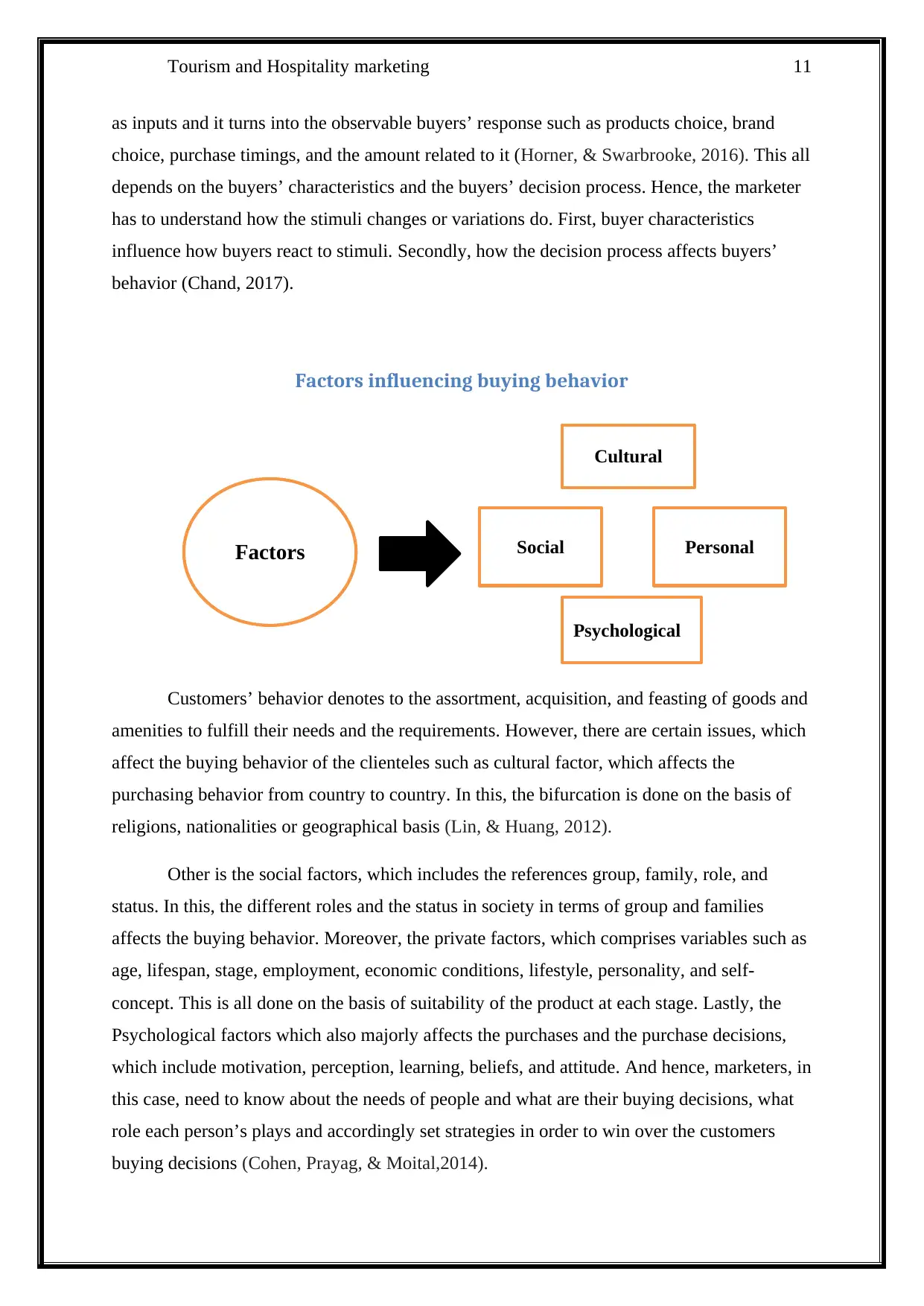
Tourism and Hospitality marketing 11
as inputs and it turns into the observable buyers’ response such as products choice, brand
choice, purchase timings, and the amount related to it (Horner, & Swarbrooke, 2016). This all
depends on the buyers’ characteristics and the buyers’ decision process. Hence, the marketer
has to understand how the stimuli changes or variations do. First, buyer characteristics
influence how buyers react to stimuli. Secondly, how the decision process affects buyers’
behavior (Chand, 2017).
Factors influencing buying behavior
Customers’ behavior denotes to the assortment, acquisition, and feasting of goods and
amenities to fulfill their needs and the requirements. However, there are certain issues, which
affect the buying behavior of the clienteles such as cultural factor, which affects the
purchasing behavior from country to country. In this, the bifurcation is done on the basis of
religions, nationalities or geographical basis (Lin, & Huang, 2012).
Other is the social factors, which includes the references group, family, role, and
status. In this, the different roles and the status in society in terms of group and families
affects the buying behavior. Moreover, the private factors, which comprises variables such as
age, lifespan, stage, employment, economic conditions, lifestyle, personality, and self-
concept. This is all done on the basis of suitability of the product at each stage. Lastly, the
Psychological factors which also majorly affects the purchases and the purchase decisions,
which include motivation, perception, learning, beliefs, and attitude. And hence, marketers, in
this case, need to know about the needs of people and what are their buying decisions, what
role each person’s plays and accordingly set strategies in order to win over the customers
buying decisions (Cohen, Prayag, & Moital,2014).
Factors
Cultural
PersonalSocial
Psychological
as inputs and it turns into the observable buyers’ response such as products choice, brand
choice, purchase timings, and the amount related to it (Horner, & Swarbrooke, 2016). This all
depends on the buyers’ characteristics and the buyers’ decision process. Hence, the marketer
has to understand how the stimuli changes or variations do. First, buyer characteristics
influence how buyers react to stimuli. Secondly, how the decision process affects buyers’
behavior (Chand, 2017).
Factors influencing buying behavior
Customers’ behavior denotes to the assortment, acquisition, and feasting of goods and
amenities to fulfill their needs and the requirements. However, there are certain issues, which
affect the buying behavior of the clienteles such as cultural factor, which affects the
purchasing behavior from country to country. In this, the bifurcation is done on the basis of
religions, nationalities or geographical basis (Lin, & Huang, 2012).
Other is the social factors, which includes the references group, family, role, and
status. In this, the different roles and the status in society in terms of group and families
affects the buying behavior. Moreover, the private factors, which comprises variables such as
age, lifespan, stage, employment, economic conditions, lifestyle, personality, and self-
concept. This is all done on the basis of suitability of the product at each stage. Lastly, the
Psychological factors which also majorly affects the purchases and the purchase decisions,
which include motivation, perception, learning, beliefs, and attitude. And hence, marketers, in
this case, need to know about the needs of people and what are their buying decisions, what
role each person’s plays and accordingly set strategies in order to win over the customers
buying decisions (Cohen, Prayag, & Moital,2014).
Factors
Cultural
PersonalSocial
Psychological
⊘ This is a preview!⊘
Do you want full access?
Subscribe today to unlock all pages.

Trusted by 1+ million students worldwide
1 out of 29
Related Documents
Your All-in-One AI-Powered Toolkit for Academic Success.
+13062052269
info@desklib.com
Available 24*7 on WhatsApp / Email
![[object Object]](/_next/static/media/star-bottom.7253800d.svg)
Unlock your academic potential
Copyright © 2020–2025 A2Z Services. All Rights Reserved. Developed and managed by ZUCOL.





